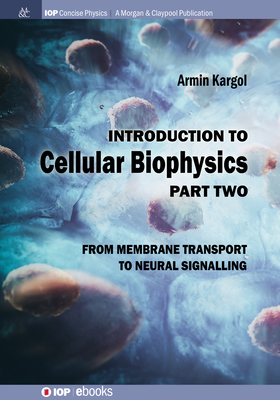Introduction to Cellular Biophysics, Volume 2: From Membrane Transport to Neural Signalling

Introduction to Cellular Biophysics, Volume 2: From Membrane Transport to Neural Signalling
All living matter is comprised of cells, small compartments isolated from the environment by a cell membrane and filled with concentrated solutions of various organic and inorganic compounds.
Some organisms are single-cell, where all life functions are performed by that cell. Others have groups of cells, or organs, specializing in one particular function. The survival of the entire organism depends on all of its cells and organs fulfilling their roles.
While the cells are studied by different sciences, they are seen differently by biologists, chemists, or physicists. Biologists concentrate their attention on cell structure and function. What the cells consists of? Where are its organelles? What function each organelle fulfils? From a chemists' point of view, a cell is a complex chemical reaction chamber where various molecules are synthesized or degraded. The main question is how these, sometimes very complicated chains of reactions are controlled. Finally, from a physics standpoint, some of the fundamental questions are about the physical movement of all these molecules between organelles within the cell, their exchange with the extracellular medium, as well as electrical phenomena resulting from such transport. The aim of this book is to look into the basic physical phenomena occurring in cells. These physical transport processes facilitate chemical reactions in the cell and various electrical effects, and that in turn leads to biological functions necessary for the cell to satisfy its role in the mother organism. Ultimately, the goals of every cell are to stay alive and to fulfill its function as a part of a larger organ or organism. The first volume of this book is an inventory of physical transport processes occurring in cells while this second volume provides a closer look at how complex biological and physiological cell phenomena result from these very basic physical processes.
PRP: 407.49 Lei
Acesta este Pretul Recomandat de Producator. Pretul de vanzare al produsului este afisat mai jos.
366.74Lei
366.74Lei
407.49 LeiIndisponibil
Descrierea produsului
All living matter is comprised of cells, small compartments isolated from the environment by a cell membrane and filled with concentrated solutions of various organic and inorganic compounds.
Some organisms are single-cell, where all life functions are performed by that cell. Others have groups of cells, or organs, specializing in one particular function. The survival of the entire organism depends on all of its cells and organs fulfilling their roles.
While the cells are studied by different sciences, they are seen differently by biologists, chemists, or physicists. Biologists concentrate their attention on cell structure and function. What the cells consists of? Where are its organelles? What function each organelle fulfils? From a chemists' point of view, a cell is a complex chemical reaction chamber where various molecules are synthesized or degraded. The main question is how these, sometimes very complicated chains of reactions are controlled. Finally, from a physics standpoint, some of the fundamental questions are about the physical movement of all these molecules between organelles within the cell, their exchange with the extracellular medium, as well as electrical phenomena resulting from such transport. The aim of this book is to look into the basic physical phenomena occurring in cells. These physical transport processes facilitate chemical reactions in the cell and various electrical effects, and that in turn leads to biological functions necessary for the cell to satisfy its role in the mother organism. Ultimately, the goals of every cell are to stay alive and to fulfill its function as a part of a larger organ or organism. The first volume of this book is an inventory of physical transport processes occurring in cells while this second volume provides a closer look at how complex biological and physiological cell phenomena result from these very basic physical processes.
Detaliile produsului








